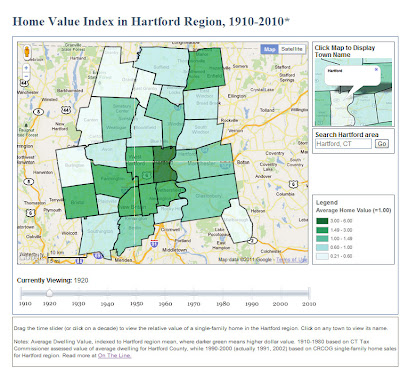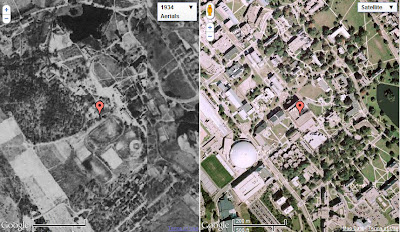This is the second post in the Outside the Neatline Blog series focusing on web-based maps developed by the University of Connecticut Libraries Map and Geographic Information Center (MAGIC) for the On The Line project.
When our research team began working with digital aerial photographs, we asked ourselves: how can we display two views of the same terrain at different points in time? Our solution was to develop a linked-control dual-view map, titled Neighborhood Change in Connecticut, 1934 to Present, which allows users to compare aerial images from past and present, side by side. Since this interactive tool is based on Google Maps web technology, it features the familiar controls to zoom and pan around the map, as well as a Google search engine for any address in Connecticut. Best of all, the linked controls means that the two images are synced: when a user moves or zooms into one side of the map, the other side automatically matches it.
This map is a wonderful tool for examining changes in land use anywhere in Connecticut. For example, compare Hartford’s Parkville neighborhood, before and after the construction of the Interstate-84 highway exchange in the 1960s, which benefited suburban commuters but divided urban neighborhood irrevocably. See also the conversion of rural farmland into post-war suburban residential and commercial developments, such as the WestFarms Mall area in Farmington/West Hartford, or the Bishop’s Corner shopping center in West Hartford.

Caption: Click image to explore our Neighborhood Change map for Hartford’s Parkville area (shown above) or any other region in Connecticut.
At present, the Neighborhood Change map displays aerial imagery for selected years: 1934, 1991, 2008, and Google’s current view. Soon we will add more options to the drop-down menu: 1951-2 and 1970. Our goal is to create a tool to show neighborhood comparisons in approximately twenty-year intervals from 1934 to the present.
Another feature of this map allows anyone to create a custom URL web address to point any visitor to a specific location in Connecticut. To do this create a URL using this format,
http://magic.lib.uconn.edu/otl/dualcontrol_aerialchange.html?lat=[insert latitude]&long=[insert longitude]
and identify the latitude and longitude you are interested by going to Google Maps and right-clicking on a point, select “What’s Here?” and copying the latitude and longitude coordinates added to the Google Maps search box into the URL.
For example a URL for Westfarms shopping mall, Farmington would look like this:
http://magic.lib.uconn.edu/otl/dualcontrol_aerialchange.html?lat=41.7222&long=-72.7632
This linked-control dual-view tool may also be used to compare other types of maps, such as historic census data to the newly released 2010 census data of the United States.
We invite you to explore the Neighborhood Change in Connecticut, 1934 to Present web-based map and On The Line.
Technical detail:
This linked-control dual view map uses similar Google Maps JavaScript API version 3 and customized javascript coding for the Federal HOLC “Redlining” Map, Hartford region, 1937 map discussed in last weeks On The Line series post, but with enhanced WMS server integration. We incorporated aerial imagery into the linked-control dual view map by using Web Map Service (WMS), which is a standard protocol for using georeferenced images over the internet. MAGIC’s WMS is a Cadcorp GeognoSIS based server that includes historical aerial images and maps. All of our imagery is projected in WGS84, which allows them to be overlaid on Goggle Maps. The WMS server enables us to link aerial imagery and historical maps into our web-based maps. Integrating WMS into the web-based map was facilitated by using custom JavaScript developed by Ben Spaulding of TheGISDoctor.com and assistance from other sources. The code allows Google Maps to read the WMS server for a particular image or map and then overlay it on a Google Map interface. WMS is basically a tiled image on another server you can overlay on your Google interface. This could be done with ArcGIS Server as well. To actually reference an image or historical map from the WMS server you need the WMS server address plus the layer name; we have a page that details this at http://magic.lib.uconn.edu/mash_up/wms_layers.html
Coming next in this series — Racial Change in the Hartford Region, 1900-2010: An Animated Time Slider Map








